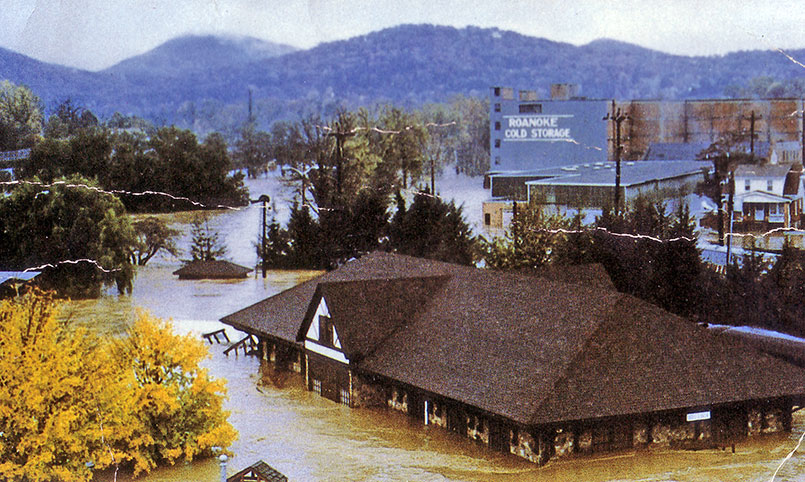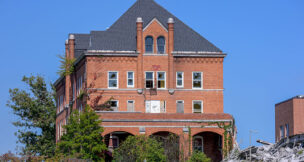
Flood waters engulf what was then called the Roanoke Transportation Museum in Wasena Park on Nov. 5, 1985. Photo by Rev. Nelson Harris, courtesy the Virginia Room

Flood waters engulf what was then called the Roanoke Transportation Museum in Wasena Park on Nov. 5, 1985. Photo by Rev. Nelson Harris, courtesy the Virginia Room
Roanoke remembers Hurricane Juan’s 1985 toll
Beth JoJack //November 2, 2025//
Summary
- The 1985 Roanoke flood killed 10 and caused $83 million in damage to businesses
- A $70 million Roanoke River Flood Reduction Project improved protections.
- Carilion Clinic installed a permanent floodwall at Carilion Roanoke Memorial Hospital in 2019
Forty years ago, remnants of Hurricane Juan dumped buckets of rain on the Roanoke Valley for days. Then, on Election Day, the area received 6.6 inches over a few hours. The Roanoke River rose to more than 23 feet.
The 1985 flood claimed 10 lives in the valley. An economic price was also paid.
“In Roanoke alone, the damage to businesses and industrial plants and equipment was estimated at nearly $83 million,” The Roanoke Times reported in a 1995 article.
Larry Davidson, the third-generation owner of Davidsons who sold the store this spring, remembers walking from the menswear shop on Jefferson Street to the city market area, where he found water had nearly reached the tables of the farmer’s market. “There was a canoe or row boat or something down there,” he recalled.
Water didn’t reach his store. Others weren’t as lucky. More than 100 businesses were damaged.
In 1985, the now-deceased Vic Thomas was a member of Virginia’s House of Delegates. He also owned Roanoke’s E.J. Thomas Market where he was working the day of the flood. According to news reports, a helicopter rescued him and a few others from the roof of the Orange Avenue store mere seconds before the angry water pulled the whole building down.
In October, Nancy Howell Agee, CEO emeritus of Carilion Clinic, shared memories of experiencing the flood from Carilion Roanoke Memorial Hospital.
“At that time there was a fairly open staircase to the first floor, and I was standing on that staircase, watching the whole lobby fill with water,” she recalled. “Big trees coming through the front door and everything was dark. It was eerie and frightening.
Over the decades following the disaster, the region has worked to become more resilient to flooding.
Between 1990 and 2012, the City of Roanoke partnered with the U.S. Army Corps of Engineers on the Roanoke River Flood Reduction Project, which is estimated to have cost more than $70 million. The work included the construction of levees and making flood storage bench cuts to widen the floodplain.
The city got the chance to test out the work when remnants of Hurricane Michael caused the Roanoke River to crest at 16.64 feet in 2018.
“We saw that the bench cuts held the water they were supposed to … so that was kind of a good test run,” says Mckenzie Brocker, Roanoke’s water quality administrator.
Carilion Roanoke Memorial Hospital, which sits near the Roanoke River, has also worked to improve flood resilience.
In 1985, water poured into the hospital’s basement where the main electrical service was located, causing much of the facility to lose power.
In 2019, Carilion Clinic installed a permanent floodwall into the façade of Roanoke Memorial. The health system has also relocated generators and other equipment “to allow for multiple power source redundancies,” according to Hannah Curtis, a Carilion spokesperson. “Like many who faced the unprecedented flooding in 1985, we took away lessons learned.”
As flooding has impacted inland communities, including Damascus in Southwest Virginia, where 140 structures were damaged or destroyed in 2024’s Hurricane Helene, Roanoke has continued its work.
In May, the city began a $2.5 million effort to improve how the stormwater system drains rainfall in a section of downtown.
Tina L. Workman, president and CEO of Downtown Roanoke Inc., which promotes economic development downtown and provides other services, says she doesn’t hear from business owners with flooding concerns.
“I feel like they go above and beyond,” Workman says of the city’s flood resiliency efforts.
P
















